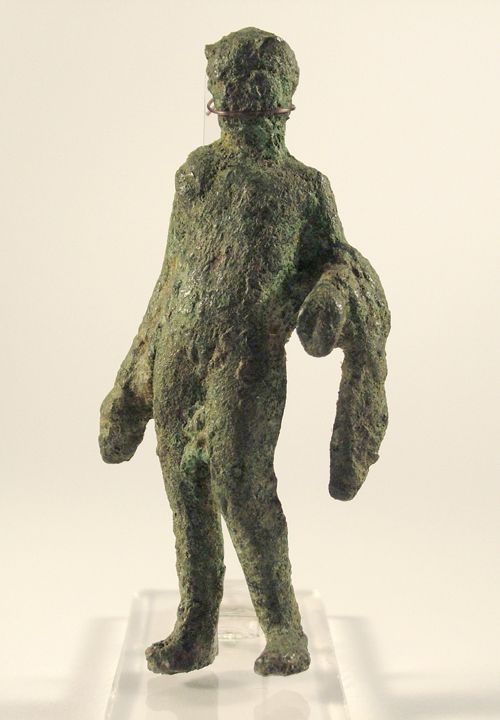1 small bronze statuette of Mercury, found at Ashton Keynes, Wiltshire.
The earliest large-scale statues had very simple forms driven by their manufacture, known as sphyrelaton, meaning hammer-driven, in which parts of the statue were made separately and joined by rivets. By the Late Archaic period, ca.500-480 B.C, sphyrelaton was overtaken as the most used technique by a more advanced method including inverting a series of wax molds that has been lost through the many years.
During the third millennium B.C., ancient foundry workers recognized through trial and error that bronze had distinct advantages over pure copper for making statues. Bronze is an alloy composed of around 90 percent copper and 10 percent tin, and, because of its lower melting point than pure copper, it will stay liquid longer when filling a mold. It also produces a better casting than pure copper. While there were many sources for copper around the Mediterranean basin in Greek and Roman antiquity, the island of Cyprus, whose very name derives from the Greek word for copper, was among the most important. Tin, on the other hand, was imported from places as far as southwest Turkey, Afghanistan, and Cornwall, England.
In Roman mythology, Mercury, also known as Mercurius, was the quick and agile messenger to the gods. Originally, he was a god of trade related to the corn crop. In fact, his name is derived from the Latin word merces, meaning “merchandise.” He was also attributed as the protector of merchants, travelers, and shopkeepers, and defamed as the patron of thieves and those who played practical jokes.
As the gods’ messenger, Mercury plays a role in many myths. In the myth of Cupid and Psyche*, he is called upon by Jupiter to make a proclamation demanding the capture of Psyche. He also plays a role in Roman poetry and theatre, much of which was based on mythology.
Many of the myths of Mercury are derived from those of the Greek Hermes. Monuments to Hermes were thought to bring good luck, and this idea was continued with Mercury as well. Another borrowed role was that of escorting the souls of the deceased to the underworld. It is speculated that the myths originated among shepherds, lending their interest in “music and fertility.” In fact, in some legends, Mercury is said to have invented the guitar-like lyre.
In art and statues, Mercury is typically depicted as a handsome young man, even boyish in appearance, wearing a white garment. Mercury often carries a money purse, symbolizing his function as patron of merchants and business owners. His fleetness as messenger of the gods is represented by a hat or sandals with wings, called Petasus and Talaria, respectively. Mercury was thus called Alipes, meaning “with the winged feet.” He is also seen carrying a caduceus**. The caduceus was used a symbol of peace, carried by ambassadors to foreign lands. Today however, it has been altered to represent physicians, the medical field, and the U.S. Army Medical Corps.
* Cupid and Psyche is a myth originally from Metamorphoses, a Latin narrative poem, written in the 2nd century AD by Lucius Apuleius Madaurensis (or Platonicus).
** The caduceus is the traditional symbol of Hermes and features two snakes winding around an often-winged staff. The caduceus was a symbol of peace, carried by ambassadors to foreign lands.
Joe Moore


